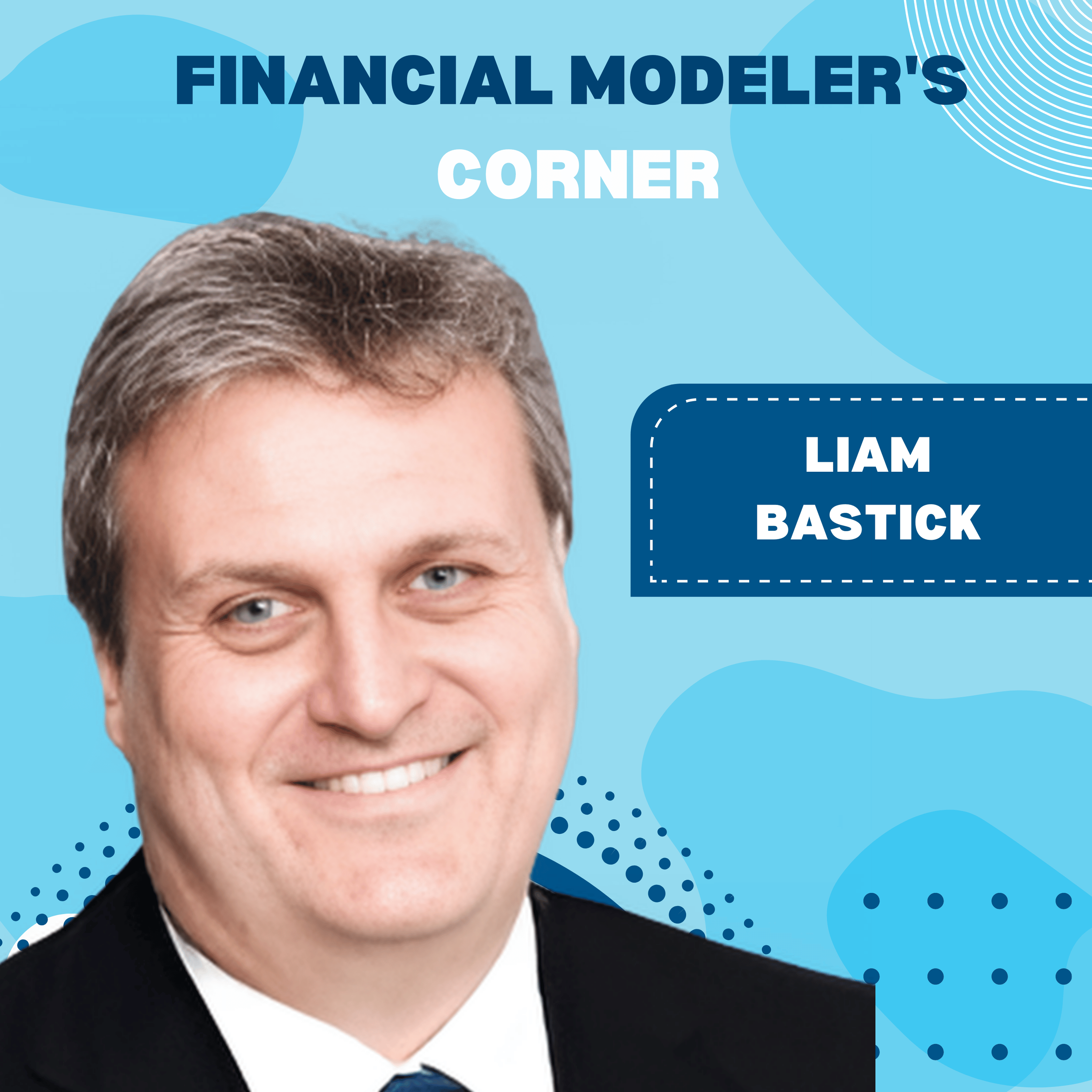
Startup vs. Corporate Financial Models & How To Build Each For Maximum Strategic Impact - Carl Olson
Carl Olson is a finance consultant and strategic advisor with more than 20 years of experience in FP&A, startup modeling, and enterprise finance. His background includes roles at Jamba Juice, Yelp, Unity, and several startups. Carl specializes in building operating and strategic models, guiding fundraising efforts, and helping businesses link financial modeling to real-world execution.
Expect to Learn:
How financial models differ for startups vs. large companies
Why listening to business partners is essential for model effectiveness
How to test assumptions when historical data is limited
The danger of over-automation in modeling
What makes a model usable vs. impressive

Financial Modeling in Retail, managing Insolvency & How Finance Can Master Cash Flow - Dave Hallwood
Dave Hallwood is the Finance Director of a group of independent fashion retailers in the UK. After spending years in retail and hospitality management, Dave transitioned into finance in his 30s, becoming a fellow of ACCA and earning his Certified Financial Modeler (CFM) designation from the Financial Modeling Institute. With a passion for practical financial modeling, Dave has built and managed models for nearly every scenario a small retailer can face, from budgeting and forecasting to store openings, closings, and insolvency planning.
Expect to Learn:
How to model retail cash flow when weather drives sales
The importance of simplicity and storytelling in financial models
What it’s like to manage an insolvency and restructure a business
Why Dave believes gut instinct still plays a big role in decision-making
How Dave uses modeling to support store openings, closures, and growth
Practical advice for switching into a finance career later in life

Financial Modelers Simplify Spreadsheets to Reduce Errors and Succeed in 2025 with Myles Arnott
Myles Arnott is a CMA-qualified accountant, Excel trainer, and fractional finance director. He leads Clarity Consultancy Services and co-founded Full Stack Modeller, a platform built to provide finance professionals with a full toolkit of modern Excel and modeling skills. Myles blends operational finance experience with teaching, making complex modeling concepts accessible through real-world insights and practice.
Expect to Learn:
The power of simplicity in model design
How to effectively prepare for the AFM exam
Best practices for managing data flow in Excel
Why Power Query is one of Excel’s most powerful tools
How Full Stack Modeler is helping professionals level up in finance
The value of designing with clarity and reviewing with confidence
Myles’s journey from complex automation to clean, intuitive spreadsheets

How Excel Transformed a Beginner into a 9 Million Follower Educator with Emma Chieppor
Emma Chieppor started her career as an actuary before launching Excel Dictionary, a platform dedicated to providing quick and practical Excel tips. Through social media, Emma has built a massive following by sharing 30-second Excel tutorials. Her expertise has helped professionals worldwide enhance their Excel skills efficiently.
Expect to Learn:
How Emma transitioned from actuary to Excel influencer
The challenges of learning Excel while starting a corporate job during COVID
Why pivot tables in financial models can be a nightmare
How Emma grew her social media following to over 9 million in less than a year
The most underrated Excel shortcuts that can save hours of work

Why Law Firm Revenue & Cash Flow Forecasting Is a Nightmare (and How to Solve It) with Sean Mooney
Sean Mooney is the founder of SJ Finance, a consultancy specializing in financial modeling automation for professional services firms. With 12+ years of executive finance experience in the UK and Australia, Sean has built financial models that have helped businesses secure millions in funding. He is an expert in Power Query, Excel automation, and M&A financial modeling, helping companies save up to 75% of reporting time through smart automation.
Expect to Learn:
The role of Power Query in automating financial modeling processes
Key revenue forecasting challenges in law firms and service businesses
How financial modeling influences business strategy and decision-making

Building Better Biotech Financial Models and Managing Valuation Risk with Frank David
Frank David is the Founder and Managing Director of Pharmagellan, a consulting firm specializing in biotech financial modeling and valuation. With a background as a physician scientist, Frank has extensive experience advising biopharma teams and investors. He also teaches at Tufts University and is the lead author of The Pharmagellan Guide to Biotech Forecasting and Valuation and The Pharmagellan Guide to Analyzing Biotech Clinical Trials.
Expect to Learn:
How patient segmentation impacts drug development strategy.
The importance of risk-adjusted modeling and scenario planning.
How financial modeling supports strategic decision-making in biotech investments.

Financial Modeling Frameworks to Build Error-Free Models In Excel Using SIMPLE Method
Babatope Agbeyo is a financial modeling expert and corporate trainer who has worked across multiple industries, including telecom, manufacturing, oil & gas, and tech. With experience at Deloitte and D Brown Consulting, he has reviewed and audited countless financial models, refining his approach through his "SIMPLE" modeling framework. Babatope is a certified AFM and FMVA and is passionate about making financial modeling more structured and effective.
Expect to Learn:
Babatope’s SIMPLE modeling framework and how it improves modeling efficiency
How to effectively audit financial models using the PAINS approach
The best industries for financial modeling and which ones are the most challenging

Financial Modeling Insights for Startups Seeking Venture Capital with Andres Klaric
Andres Klaric is the co-founder and co-CEO of Fuse, a next-generation loan origination system designed to streamline lending for financial institutions through self-serve customization, a low-code API builder, and personalized agent portfolios. He provides insights into financial modeling for startups, securing venture capital, and the critical lessons he’s learned from Wall Street.
Expect to Learn:
How startup financial models differ from corporate M&A models.
The key factors venture capitalists look for in startup projections.
Lessons from private equity and investment banking that shaped Andres as a CEO.

The Role Of Financial Modeling In Investing With Author Of "Why Does The Stock Market Go Up?" Brian Feroldi
Brian Feroldi is a financial educator, investor, and author dedicated to demystifying the stock market. With nearly two decades of investing experience, Brian has written over 3,000 articles on stocks, personal finance, and investing. His best-selling book “Why Does the Stock Market Go Up?” explains market fundamentals in simple terms. Through his YouTube channel, social media presence, and educational content, Brian helps investors make smarter decisions by focusing on business quality, valuation, and long-term investing strategies.
Expect to Learn:
The biggest mistakes investors make and how to avoid them
How Brian analyzes financial statements and what metrics he prioritizes
How to build an investing checklist to guide stock selection

Discover How Financial Modelers Are Using Copilot and ChatGPT with Global Expert Kenny Whitelaw-Jones
Kenny Whitelaw-Jones who is the founding partner at Gridlines joins the show. As a leading expert in project finance modeling, Kenny has played a pivotal role in shaping financial modeling standards globally. With over a decade of experience training blue-chip clients and developing complex models, he brings invaluable insights into how AI is poised to revolutionize financial modeling.
Expect to Learn:
How AI is expected to significantly impact financial modeling, with Kenny's recent industry survey.
The current limitations of AI tools like ChatGPT in financial modeling and where they excel.
The future skills financial modelers will need to stay ahead in an AI-driven world.

Named Ranges and External Links Fixes for Finance Professionals to Build Accurate Models with Joel Steendam
Joel Steendam is a global Excel expert and educator with a passion for helping professionals create better financial models. As a key member of PerfectXL, he develops software to improve spreadsheet quality, mitigate risks, and promote best practices in Excel. With a multicultural background and years of experience in financial modeling, Joel blends technical expertise with a deep understanding of how culture influences collaboration and problem-solving.
Expect to Learn:
Why named ranges and documentation are essential in financial modeling.
Practical advice on staying curious and learning new Excel skills.
The role of tools like PerfectXL in auditing and improving spreadsheet quality for financial modeling.

Strategic Financial Models for Finance Professionals to Build $100M Businesses with Tim Vipond
Tim Vipond began his career as an investment banking analyst and later transitioned to wealth management, corporate development, and e-commerce finance. As the co-founder of the Corporate Finance Institute, Tim has trained over 2 million students and introduced practical certifications that reshape how finance professionals develop their skills. Tim’s blend of financial expertise, entrepreneurial spirit, and focus on strategy makes him a compelling guest for this conversation.
Expect to Learn:
Why aligning financial models with business strategy is critical.
The journey of building the Corporate Finance Institute and insights into e-learning success.
The role of assumptions, execution, and scenario analysis in effective modeling.

Why Losing My Dream Job Made Me the FP&A Tools Expert with Paul Barnhurst
In this special solo episode of Financial Modeler’s Corner, host Paul Barnhurst, known as the FP&A Guy, takes the spotlight to share his personal journey from a corporate financial analyst to an influential voice in financial modeling and FP&A. This episode is packed with career highlights, trends in financial modeling, and a mix of humor to kick off the new year.
Expect to Learn:
The career journey of Paul Barnhurst of creating a thriving business and gaining global recognition.
Key lessons in financial modeling, including best practices in designing effective models.
Trends shaping financial modeling and analytics for 2025, including the role of AI.

AI vs. Human Insights in Financial Modeling to Build Accurate Models for Decision-Making
This episode features Giles Male, co-founder of Full Stack Modeler and an Excel MVP, Will Wardle, an independent financial modeler with over two decades of experience, Carolina Lago, founder of Classic Financial, specializing in FP&A and financial restructuring for SMEs, Hedieh Kianyfard, a project finance expert from Iran, known for her practical solutions to complex modeling challenges, Oz du Soleil, a YouTube star and Excel MVP, renowned for his engaging tutorials and insights, Rishi Sapra, a former accountant turned Power BI advocate, and David Brown, a seasoned financial modeler with 27 years of experience, excelling in blending Excel with Power BI.
Expect to Learn:
The impact of AI on the future of financial modeling.
How Power BI complements financial modeling by enhancing data visualization and storytelling.
The debate on the most important financial statement and how it informs decision-making.

How Excel Competitions Transform Data Professionals into Experts Using Power Query and VBA
This special episode captures the energy and innovation of the Excel Esports at the Financial Modeling World Cup (FMWC) in Las Vegas, showcasing interviews with top competitors, including Excel MVPs and data enthusiasts, while exploring how Excel competitions push the boundaries of modeling expertise.
Expect to Learn:
Unique perspectives on the creative use of Excel, from real-world modeling to themed case studies.
How Excel innovations like Power Query, dynamic arrays, and VBA are transforming data work.
Why participating in competitions like FMWC can rapidly enhance your financial modeling skills.

Transforming Excel Competitions into Million-Dollar Events with Andrew Grigolyunovich
This episode takes you to the heart of the Financial Modeling World Cup (FMWC) 2024, hosted at the HyperX Gaming Arena in Las Vegas. Known as the "Excel Esports Championship," this unique event blends competitive financial modeling with the energy of live sports entertainment. From electric arenas to engaging case competitions, discover how Excel enthusiasts and world-class modelers push the boundaries of what's possible in financial modeling.
Expect to Learn:
How the FMWC is transforming financial modeling into an exciting esport.
Insights from top modelers on preparing for high-pressure competitions.
The role of networking and community in fostering innovation and growth in the Excel world.

Excel Hacks for Financial Modelers to Simplify Valuations and Save Hours with Charles Keepman
Charles Keepman has spent years honing his skills in financial modeling, starting at Ernst & Young and later working at Economics Partners (now Ryan Valuation). With deep expertise in business valuation, Charles currently applies his modeling skills to help clients make strategic financial decisions. His career trajectory has been shaped by his passion for creating efficient and dynamic financial models that help businesses make informed, data-driven decisions.
Expect to Learn:
Key principles for building auditable, easy-to-follow financial models.
Insights into business valuation: when to use different approaches like DCF, asset, and market-based methods.
The role of Excel and financial modeling software in today’s fast-paced financial world.

The Great Debate on AI, Excel, and the Future of Financial Modeling
In this special debate episode, host Paul Barnhurst aka The FP&A Guy is joined by an all-star panel of modeling experts to tackle some of the most contentious questions in the financial modeling world. This lively discussion promises insights, entertainment, and plenty of surprises as the panelists bring their expertise and humor to the table. Together, they bring decades of experience, fresh perspectives, and a shared passion for the art and science of financial modeling.
Expect to Learn:
Why financial models are (or aren’t) the ultimate decision-making tool for businesses.
The role of Excel in the future: is it here to stay, or will it be replaced by emerging technologies?
Power BI, Power Query, and Python in financial modeling—are they worth learning?

How Aligning Strategy with Modeling Transforms Corporate Deals with Sean Corcoran
Sean Corcoran is the Head of Corporate Development at DigiCert and has an illustrious career spanning Fortune 50 companies, private equity-backed ventures, and public firms. With experience leading over 60 acquisitions worth billions, Sean has a comprehensive understanding of the M&A lifecycle, strategic planning, and financial modeling.
Expect to Learn
Why simplicity and strategy are vital in corporate development financial models.
Common pitfalls in financial models and how to avoid them.
The importance of aligning strategic intent and integration during acquisitions.

Excel Problem-Solving Strategies for Financial Modelers to Build Robust Models with Liam Bastick
Liam Bastick is a seasoned corporate trainer, author, and financial modeling expert, with a focus on Excel, Power BI, and AI applications. With a career that includes awards like Microsoft’s Most Valuable Professional and the inaugural Lifetime Achievement, international recognition, and extensive teaching, Liam provides listeners with both practical advice and fascinating anecdotes from his career.
Expect to Learn:
Excel optimization tips and learn how to effectively use Quick Access toolbar
Challenges and advantages of modeling in Power BI
How AI is changing financial modeling and what the future might hold
